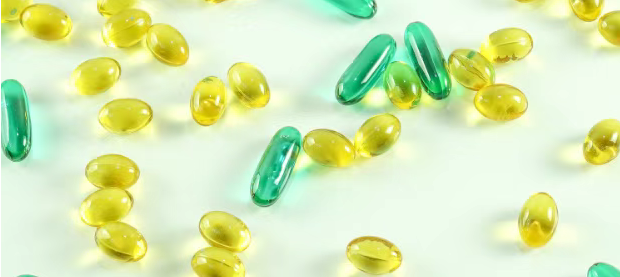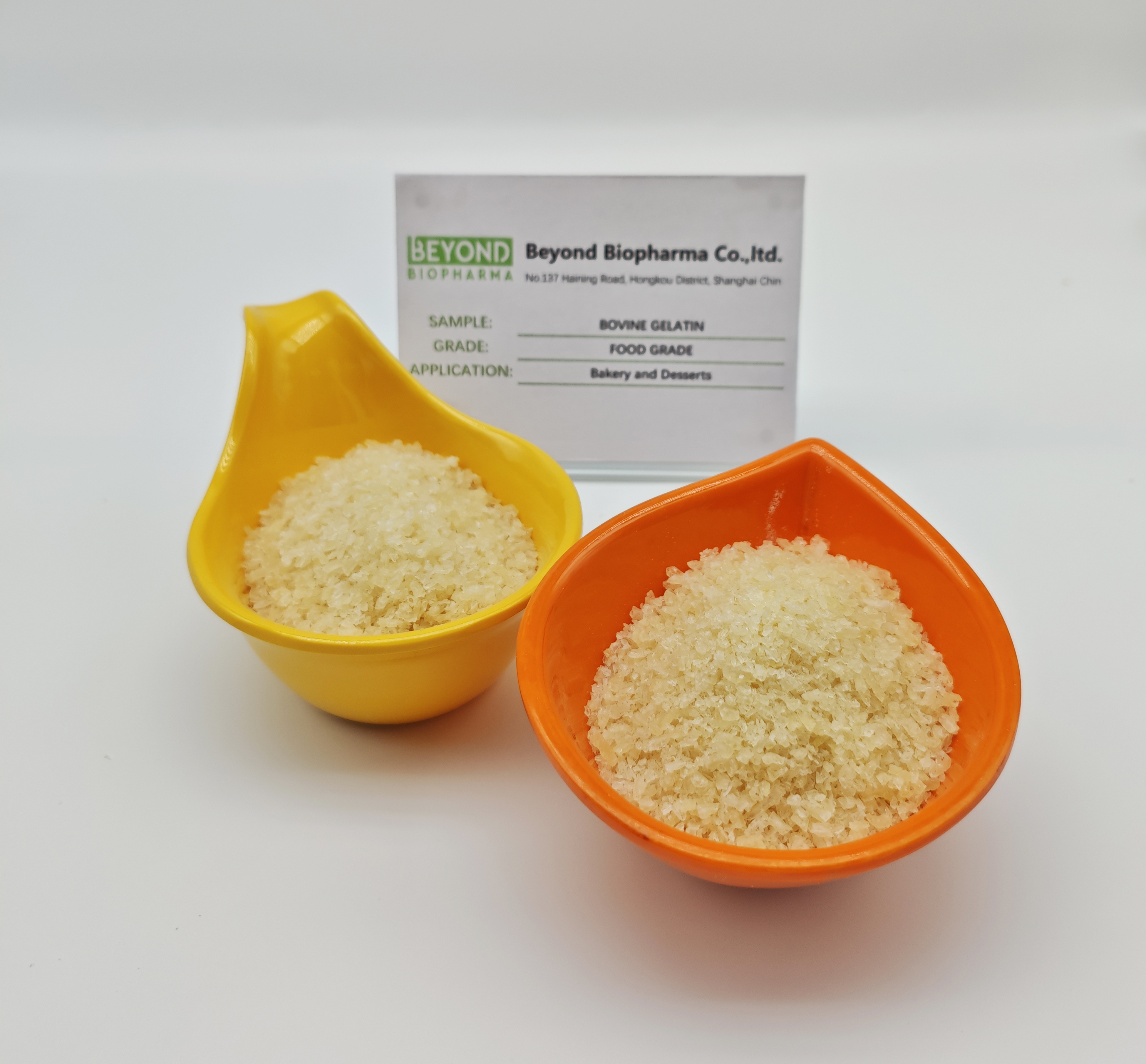Applications of Gelatin in the Food Industry
In addition to its thermoreversible gelling properties, the confectionery industry has taken advantage of the versatility of gelatin for a variety of applications. Gelatin is essential for the formation and stabilization of foams in confectionery, as well as for binding, emulsification, and regulating sugar crystallization. The thermoreversible gelling property is particularly valuable in confectionery for the production of soft candies, marshmallows, and other gel-based snacks. Altan et al. tested rainbow trout skin gelatin ( Oncorhynchus mykiss ) with different concentrations of confectionery solutes as an alternative to mammalian gelatin. The addition of sorbitol and sucrose (10 g/100 mL) enhanced the rheological properties. The gel strength increased from 828 Pa to 2317 Pa and 1996 Pa after the addition of sorbitol and sucrose. The melting points of sorbitol and sucrose increased from 17.5°C to 22°C and 22.1°C, respectively. The results showed that sorbitol and sucrose induced more junctions, which increased hardness and chewiness, showing the potential of fish gelatin in soft candies.
Gelatin’s foam formation and stability make it an important ingredient in the production of aerated confections such as marshmallows and nougat. It helps to create and stabilize the foam structure, giving these confections a light and fluffy texture. In Eddy and Editya’s study, they used gelatin extracted from the skin of Epihinephelus sp. to produce marshmallows. The results showed that the marshmallows had specific physical properties, including a chewiness of 53.62 N, a springiness of 72.93%, and a density of 0.93 g/mL. In addition, their sensory qualities were 3.47 for texture, 3.43 for taste, 3.27 for aroma, and 3.50 for color. In addition, Tinratat and Sila-asna studied fish skin gelatin and found that it could be effectively used in panna cotta products.

In addition, gelatin can also act as a binder to help bind various ingredients in confectionery products together. Specifically, it binds nuts, fruits, and other ingredients together to form chocolate bars, fruit gels, and nougat. Gelatin also improves the emulsification of fat and water-based ingredients in confectionery. This is useful in applications such as chocolate and toffee as it helps achieve a smooth and creamy mouthfeel.
In addition, preventing unwanted sugar crystallization is essential for the confectionery industry to achieve the desired texture and appearance. Gelatin is an effective anti-crystallization agent that ensures that confectionery such as gummies and caramels remain smooth and free of unwanted sugar crystals.
Choobkar et al. explored the effectiveness of carp skin gelatin as a replacement for bovine gelatin in the production of gummies as it could improve nutritional value. Results showed that 75% carp skin gelatin had a more significant effect on protein and essential elements, especially phosphorus and iron, compared to 100% commercial bovine gelatin. According to Choi and Regenstein, fish gelatin has similar physical and chemical properties to porcine gelatin and scored higher in blind sensory tests. In addition, according to their study, the lower melting point of cold-water fish gelatin can improve fruit aroma, flavor release, and melting rate of hydrogel desserts. By leveraging these diverse properties of gelatin, the confectionery industry can produce a wide range of delicious and consistent confections, each with its own unique texture and mouthfeel.

In addition to its role in desserts and jellies, gelatin is also critical in enhancing the quality of certain dairy products and pastries, ensuring that these shelf-stable foods meet consumer expectations. Milk is fundamentally a complex emulsion of water and oil. The addition of gelatin to dairy products enhances its emulsifying properties by adhering gelatin molecules to the surface of fat droplets, thereby reducing the surface tension within the aqueous phase. The addition of gelatin to dairy products serves a variety of purposes. It aids in the retention of whey in the product matrix, preventing unwanted separation of the aqueous whey, which is particularly evident in yogurt, curd and cream cheese. In addition, when gelatin is added to milk desserts, it plays a key role in modifying the surface tension of the water. This modification helps to form and maintain foams through mechanical agitation or gas injection. Gelatin can also contribute to ice cream production by modifying the size and dispersion of ice crystals formed during freezing, which can have a significant impact on the final taste and texture of ice cream products.

Tilapia skin gelatin (TSG) has been used as a replacement for mammalian gelatin in yogurt. TSG has lower melting and gelling temperatures compared to bovine gelatin. Moreover, tilapia skin gelatin was shown to be effective in improving the water holding capacity of acidic latex gels. The study concluded that the rheological, water holding, textural, and sensory aspects of TSG were comparable and replaceable to bovine gelatin in yogurt. A similar study was conducted by Cheng et al. investigating a low-fat spread made from pectin and fish gelatin. The effects of salt addition and pH changes on this spread were investigated using temperature scanning, bulk density measurements, texture analysis, and morphological evaluation. According to this study, reducing the ratio of fish gelatin to pectin increased the bulk density, hardness, compressibility, adhesion, elasticity, and meltability of the spread. Furthermore, spreads made with high acidity also experienced dehydration, but this could be prevented by the addition of sodium chloride.
The poor melting properties of fish gelatin can be used in a variety of dry products, including microencapsulation. Microencapsulation of vitamins and other pharmaceutical additives, such as azaxanthines, is one of the main uses of fish gelatin. It can also be used as a microencapsulator for colorants. Soper uses warm water fish gelatin (150-300 saturation) to microencapsulate food flavors, such as vegetable oils, garlic flavor, lemon oil, apple flavor or black pepper. The production of microcapsules results from this complex coacervation process, which takes place at temperatures between 33 and 35°C. Most encapsulation experts have already mastered the necessary proficiency in managing fish gelatin in their advanced processes, using only relatively small amounts of fish gelatin to produce softgel capsules. Fish gelatin softgel capsules are mainly used in the field of dietary supplements.
Pharmaceutical and medical industries
Gelatin has a wide range of applications in the field of pharmaceuticals and medical products. It is a key component of plasma substitutes used in intensive care and surgical procedures. Replacing gelatin with fish gelatin eliminates perioperative allergic reactions associated with mammalian gelatin. In addition, gelatin is used to produce vitamin-coated products, lozenges and tablets, as well as pellets, paste dressings and sponges. In addition, it plays a vital role in the development of innovative vaccine formulations. It is noteworthy that about 90% of pharmaceutical grade gelatin is used to produce capsules, both soft and hard capsules. In addition, fish gelatin is expected to be a potential component in wound healing and tissue regeneration processes due to its high biodegradability, biocompatibility, and low antigenicity. Fish gelatin shows great promise in treating various diseases. Osteoporosis is one such disease, which is characterized by the loss of bone calcium, leading to osteoporosis and increased bone brittleness, ultimately reducing bone density. A study by Nomura et al. showed that shark skin gelatin can promote bone formation and enhance type 1 collagen. Another study by Naomi et al. used fish gelatin to reduce bone brittleness, revealing its great potential. Studies by Kearney et al. and Cheng et al. explored the possibility that hypertension is an important risk factor for cardiovascular disease, and fish gelatin has the potential to become an effective antihypertensive agent.


Nutritional and Health Benefits
Gelatin is a valuable source of protein, free of cholesterol and sugar, and almost fat-free. It is highly digestible and can be completely decomposed in the human body. Research shows that gelatin has been used in foods to increase the protein content of low-fat foods and reduce the carbohydrate, salt and fat content, and also as a vitamin carrier. Gelatin may benefit the motor and skeletal systems, especially bones, tendons, cartilage and ligaments. In addition, there are studies that show that regular consumption of gelatin may help strengthen hair and connective tissue, make the skin firm, hair shiny and nails elastic.

Post time: Jun-11-2025